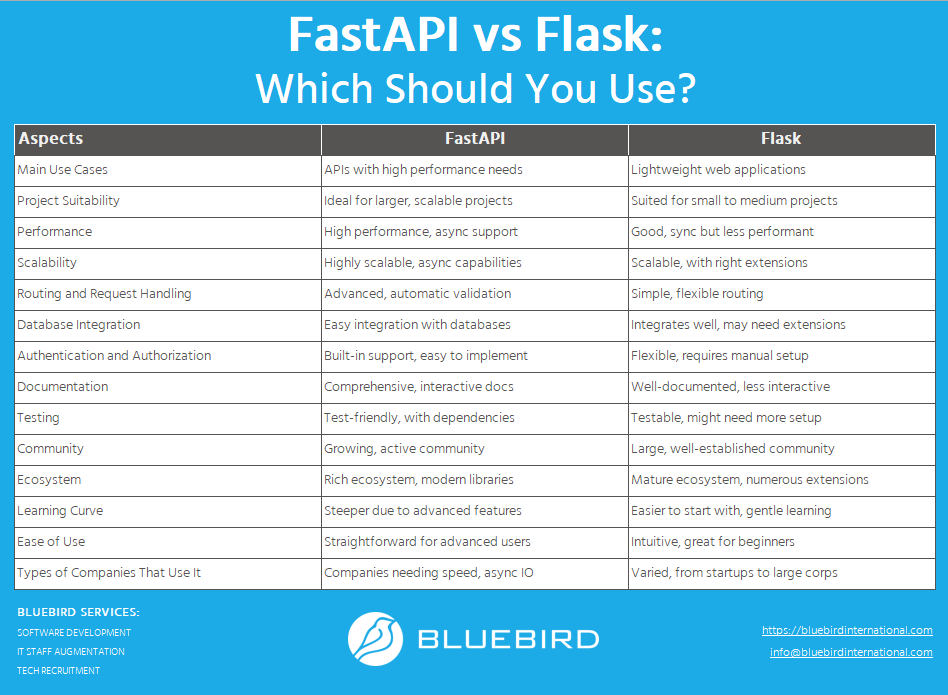We compare FastAPI vs Flask, providing you with the insights needed to choose the best framework for your Python project.
More...
FastAPI vs Flask? In this blog post, we will be discussing the two popular Python web frameworks - FastAPI and Flask.
FastAPI and Flask have gained widespread popularity due to their different approaches to web development. While FastAPI is a modern, fast (high-performance) web framework for building APIs with Python 3.7+ based on standard Python type hints, Flask is a lightweight web framework that is easy to use and highly customizable.
We'll look at the key differences between these two frameworks, compare their use cases, and help you decide which one is ideal for your project. Through this comparison, we hope to present you with useful insights that will help you make an informed decision on which framework to choose for your project.

Introduction to FastAPI and Flask
When it comes to developing web applications, choosing the right Python web framework is crucial. FastAPI vs Flask: two popular options that have gained traction in recent years. In this section, we will introduce you to these two frameworks and highlight their key features and differences.
1. FastAPI
FastAPI is a modern web framework for building APIs with Python 3.7+. It prioritizes speed and performance, making it an excellent choice for high-traffic projects. FastAPI uses standard Python type hints to enable fast and easy development, automatic API documentation, and editor support. It also comes with built-in support for asynchronous programming patterns, making it a top contender for building real-time applications.
2. Flask
On the other hand, Flask is a lightweight web framework that is easy to use and highly customizable. It is ideal for small to medium-sized web applications and RESTful APIs. Flask follows the minimalist philosophy of "micro-frameworks," which encourages developers to pick and choose their own libraries and extensions for customizing the framework to their liking. Flask's simplicity and flexibility make it an excellent choice for prototyping and quick web development.
FastAPI vs Flask: Performance And Scalability
When comparing web frameworks, performance and scalability are critical factors to consider. FastAPI and Flask have different approaches to handling these aspects of web development.
FastAPI has a reputation for high performance, thanks to its use of Pydantic models and Starlette for handling requests. It can handle a huge number of requests per second, making it an excellent choice for applications that require high throughput. FastAPI also includes an asynchronous programming paradigm, allowing developers to write non-blocking code that runs faster and uses fewer resources.
Flask, while not as fast as FastAPI, is still a performant framework. It uses Werkzeug for handling requests and Jinja2 for templating, providing a reliable foundation for building web applications. Flask has a simplified approach to request handling, which can make it easier to work with for smaller applications.
1. Performance Benchmarks
FastAPI outperforms Flask in terms of requests per second and max concurrent requests. However, it's important to note that these benchmarks are specific to the test environment and application requirements. Your mileage may vary depending on your specific use case.
2. Scalability
Both FastAPI and Flask are scalable frameworks that can handle larger applications. FastAPI's asynchronous programming paradigm and use of Pydantic models make it well-suited for handling high throughput and scaling to larger applications. Flask's modular design and simplified approach to request handling also make it scalable, albeit to a lesser extent than FastAPI.
When it comes to performance and scalability, the choice of FastAPI vs Flask largely depends on your application's requirements. If you need high throughput and scalability, FastAPI may be the better choice. If you're building a smaller application or have less demanding requirements, Flask may be a more straightforward and easier-to-use option.
FastAPI Vs Flask: Routing and Request Handling
Efficient routing and request handling are crucial for web development to ensure fast and reliable communication between the client and server. In this section, we will compare the routing and request handling mechanisms of FastAPI vs Flask, including their syntax, features, and ease of use.
1. FastAPI
FastAPI provides a powerful routing system that is based on standard Python type hints. This makes it easier for developers to create endpoints and handle requests. FastAPI also supports asynchronous request handling, which allows for better performance on high-traffic applications.
The routing system in FastAPI is intuitive and easy to understand. Developers can define routes using the @app.route() decorator, with the URL pattern specified as the parameter. FastAPI also provides parameter conversion, allowing developers to specify types for the parameters in the URL, such as integers or floats. This significantly reduces the error-prone task of parsing URL parameters.
Request handling in FastAPI is both synchronous and asynchronous. Users can specify which function is asynchronous by using the async def syntax. This makes FastAPI ideal for handling high-concurrency, resource-intensive applications. FastAPI also provides automatic documentation generation for all defined routes, making it easier for developers to document their APIs.
2. Flask
Flask also provides a routing system that is easy to use and highly customizable, however, it is not based on standard Python type hints. Developers define routes using the @app.route() decorator, with the URL pattern specified as the parameter.
Request handling in Flask is synchronous, meaning it can only handle one request at a time per process. Flask also provides a simple, yet powerful, request object that allows developers to access request data such as headers, cookies, and form data.

Framework | Routing and Request Handling |
|---|---|
FastAPI | Intuitive routing system based on standard Python type hints. Asynchronous request handling for better performance on high-traffic applications. Automatic documentation generation for all defined routes. |
Flask | Simple and highly customizable routing system. Synchronous request handling, making it less optimal for high-concurrency, resource-intensive applications. |
Overall, FastAPI's modern and intuitive routing system coupled with asynchronous request handling make it a better choice for high-concurrency, resource-intensive applications. However, Flask's simple routing system and powerful request object make it a better choice for smaller, less complex applications.
FastAPI Vs Flask: Database Integration
One of the most important aspects of building robust web applications is the ability to integrate databases seamlessly. FastAPI and Flask both provide support for integrating with various popular databases and ORMs.
1. FastAPI
FastAPI offers built-in support for popular databases such as SQLite, PostgreSQL, MySQL, and many more. It also supports integration with popular ORMs such as SQLAlchemy, Tortoise ORM, and GINO. FastAPI's support for asynchronous code also extends to database operations, making querying and interacting with databases performant and efficient.
2. Flask
Flask, on the other hand, does not come with built-in support for databases. However, it provides extensions such as Flask-SQLAlchemy and Flask-MySQL that integrate with popular databases. Flask also supports working with ORMs, including SQLAlchemy and Pony ORM. Despite the lack of built-in support, Flask's extensions provide users with the flexibility to choose the database and ORM that best suit their needs.
Overall, both FastAPI and Flask offer robust and flexible options for integrating databases and ORMs into web applications. FastAPI's built-in support for databases and async code gives it an edge in terms of performance, while Flask's flexibility in choosing the best-suited database and ORM makes it a popular choice among developers.
FastAPI Vs Flask: Authentication and Authorization
Ensuring the security of a web application is paramount for any developer. Both FastAPI and Flask offer various solutions for authentication and authorization, but with some differences that are worth considering.
FastAPI's Authentication and AuthorizationFastAPI provides built-in support for authentication using OAuth2 (Open Authorization 2.0). This authentication method is widely used in many web applications where third-party access is required. In FastAPI, you can use OAuth2 with password, client credentials, and JWT (JSON Web Tokens) grant types. FastAPI also has built-in support for authorization that works with OAuth2 scopes. With scopes, you can define which parts of an application a user can access, resulting in a more granular approach to authorization. | |
 | Flask's Authentication and AuthorizationFlask does not provide built-in support for authentication or authorization. Instead, the Flask-Login extension can be used for authentication, and Flask-Security can be used for authorization. Flask-Login provides a user session management system and handles the common tasks of logging in, logging out, and remembering users between requests. Flask-Security, on the other hand, provides a wide range of security features, including authentication, authorization, and password hashing. It also supports SQLAlchemy and MongoEngine for user management, making it a versatile tool for securing web applications. |
 | Comparing FastAPI vs Flask's Authentication and AuthorizationFastAPI's built-in OAuth2 support for authentication and authorization makes it an attractive option for developers who require third-party access and a more refined approach to authorization. Meanwhile, Flask's authentication and authorization capabilities are provided through extensions, which can add some flexibility, but also some complexity to the application. Overall, both FastAPI and Flask provide robust solutions for authentication and authorization, and the choice between them may come down to the specific needs of your project and personal preference. |
FastAPI Vs Flask: Documentation and Testing
Developers need clear and comprehensive documentation to ensure smooth integration and maintenance of web applications. In this section, we will evaluate the documentation quality and testing capabilities of FastAPI vs Flask.
1. FastAPI Documentation and Testing
FastAPI offers excellent documentation, which is available online and searchable by keyword. It provides step-by-step guides, code examples, and detailed documentation of all features and functions. FastAPI documentation also includes a user-friendly interactive API documentation (Swagger UI) that allows developers to test the API's functionality and parameters.
FastAPI has a built-in testing framework based on Python's unittest module. The framework allows developers to write and run tests for their application's API endpoints. The framework supports various testing methodologies, including unit testing and integration testing. FastAPI also provides support for popular testing frameworks such as Pytest.
2. Flask Documentation and Testing
Flask documentation is well organized and easy to navigate, with a comprehensive API reference. However, Flask's documentation lacks detailed tutorials and examples. Flask provides interactive API documentation (Swagger UI) through the Flask-RESTful extension, which allows developers to test their API endpoints.
Flask has a built-in testing framework that provides support for unit testing and integration testing. Developers can use popular testing frameworks such as Pytest and Nose to write and run tests. Flask also provides a test client that allows developers to simulate API requests and test their application's responses.

Both FastAPI and Flask offer built-in testing frameworks that support unit testing and integration testing. FastAPI takes the lead when it comes to documentation because of its user-friendly and interactive documentation environment. Although Flask provides a comprehensive API reference, it lacks detailed tutorials and examples.
FastAPI Vs Flask: Community And Ecosystem
When choosing a web framework, it's important to consider the size and activity of its community. A strong community provides a wealth of resources, such as documentation, support channels, plugins, and libraries, that can help you develop your project more efficiently.
In terms of community size, Flask is a well-established web framework that has been around for over a decade. With a large and active community, Flask has an extensive ecosystem of plugins and libraries that cater to almost any use case. However, the sheer number of available options can be overwhelming, and not all plugins are actively maintained.
FastAPI, although a newer framework, has experienced rapid growth in popularity thanks to its intuitive design and superior performance. Its community, while not as large as Flask's, is active, supportive, and growing. FastAPI has a smaller but fast-growing ecosystem of plugins and libraries, with many actively maintained options for database management, authentication, and more.
Community and Ecosystem | FastAPI | Flask |
|---|---|---|
Community size | Active and growing | Large and well-established |
Plugin and Library Ecosystem | Small but fast-growing, with actively maintained options for database management, authentication, and more | Extensive, with many available options but not all are actively maintained |
Support and Documentation | Active and supportive community with comprehensive documentation and tutorials | Large and active community with extensive documentation, although not all plugins are well-documented |
Both FastAPI and Flask have active and supportive communities, providing ample resources to help you develop your web projects. Flask's larger ecosystem might provide more options, but FastAPI's rapidly growing ecosystem is catching up quickly. Therefore, when choosing of FastAPI vs Flask, consider the specific plugin or library you need and evaluate its active maintenance status before deciding.
FastAPI Vs Flask: Use Cases and Project Suitability
Choosing the right web framework for your project requires careful consideration of the framework's use cases and its suitability for your project requirements. In this section, we will discuss the types of projects and scenarios where FastAPI and Flask are best suited, helping you make an informed decision.
FastAPI
FastAPI is best suited for:
- 1High-performance APIs that require fast response times and high throughput
- 2Projects that demand scalability and handling of large volumes of requests
- 3Development teams that prioritize type hints, automatic API documentation, and validation
- 4Robust security requirements that need support for authentication, authorization, and JWT tokens
- 5Real-time applications that require WebSockets and server-side events
Flask
Flask is best suited for:
- 1Small to medium size projects that require a lightweight and flexible framework
- 2Development teams that prefer a more customizable and unopinionated approach to web development
- 3Projects that demand less overhead and simpler codebase
- 4Porting existing web applications to Python, thanks to a shallow learning curve
- 5Web applications that require integration with third-party libraries and extensions
Ultimately, the choice of FastAPI vs Flask depends on your project's specific requirements, constraints, and team's preferences. By considering the use cases and project suitability of both frameworks, you can select the one that best fits your needs and development style.
FastAPI Vs Flask: Learning Curve and Ease of Use
Learning a new web framework can be a daunting task, and it's essential to consider the learning curve and ease of use when choosing the right one for your project. In this section, we will analyze the learning curve and ease of use of FastAPI and Flask, taking into account various factors such as documentation quality, community support, and available learning resources.
1. FastAPI
FastAPI has a relatively steep learning curve compared to Flask due to its reliance on Python type hints, which require some familiarity with Python's syntax. However, FastAPI provides excellent documentation, which makes the learning process smoother. The documentation includes a comprehensive tutorial, a user guide, and an API reference. FastAPI's documentation is well-organized, easy to navigate, and contains detailed examples, making it easy for developers to understand and implement its features.
FastAPI also has an active community, which provides support through GitHub issues, a forum, and a Gitter chat room. The community is friendly and responsive, making it easy for developers to get help when needed. There are also several third-party resources available, such as courses, tutorials, and blog posts, which can aid in the learning process.
2. Flask
Flask has a shallow learning curve, making it an ideal choice for beginners. Flask's simplicity stems from its minimalistic design, with essential features that are easy to understand and implement. Flask's documentation is also excellent, with a quickstart guide, a tutorial, and an API reference. The documentation provides clear and concise examples, making it easy for developers to get started with Flask.
Flask has a large and active community, which provides support through GitHub issues, a mailing list, and a Discord chat. The community is welcoming and helpful, making it easy for developers to get help when needed. There are also numerous third-party resources available, such as courses, tutorials, and blog posts, which can aid in the learning process.
3. Summary
Both FastAPI and Flask provide excellent documentation, an active community, and multiple third-party resources that make learning easy. However, FastAPI has a steeper learning curve due to its reliance on Python type hints, while Flask has a shallow learning curve due to its minimalistic design. Ultimately, the choice of FastAPI vs Flask will depend on the developer's familiarity with Python and the complexity of the project being developed.
FastAPI Vs Flask: Performance Benchmarks and Real-world Examples
Now that we have explored the key aspects of FastAPI and Flask, it's time to review how they perform in real-world scenarios. To do this, we will analyze performance benchmarks and examine examples of FastAPI and Flask applications in the wild.
 | Performance BenchmarksFastAPI's claim to fame is its speed and performance, and it certainly does not disappoint in benchmark tests. According to the TechEmpower benchmarks, FastAPI performs significantly faster than Flask in every category, including JSON serialization, plaintext, and database queries. In fact, FastAPI ranks as one of the fastest Python web frameworks currently available, outranked only by Falcon and Sanic. Flask, while not as fast as FastAPI, still holds its own in benchmark tests. It is faster than many other popular Python web frameworks, such as Django and Pyramid, in categories such as plaintext and database queries. Flask also performs well in JSON serialization, but not quite as fast as FastAPI. |
 | Real-world ExamplesLet's take a look at some real-world examples of FastAPI vs Flask applications to see how they are used in practice. FastAPI is commonly used for building high-performance APIs that are scalable and easy to maintain. One impressive example is the OpenAPI project, which provides a free and open standard for building APIs. The OpenAPI project uses FastAPI to power its own API, showcasing the framework's ability to handle complex use cases with ease. Flask, on the other hand, is widely used for building smaller, simpler web applications. One popular example is the microblogging platform, Flaskr. Flaskr is a lightweight and easy-to-use platform that enables users to create and share posts, showcasing Flask's flexibility and simplicity. |
Framework | Pros | Cons |
|---|---|---|
FastAPI | 1. Extremely fast and performant | 1. Limited documentation and community support compared to Flask |
Flask | 1. Highly customizable and flexible | 1. Slower performance compared to FastAPI |
As we can see from the table above, both FastAPI and Flask have their pros and cons.
Overall, FastAPI is a great choice for developers who prioritize performance, scalability, and ease of use. It is particularly well-suited for building high-performance APIs that require strong typing and intuitive syntax. On the other hand, Flask is an excellent choice for developers who value flexibility, simplicity, and a large ecosystem of plugins and libraries. It is ideal for building smaller web applications, such as microservices and hobby projects.
Final Thoughts
After our detailed comparison of FastAPI vs Flask, we can say that both frameworks have their strengths and weaknesses. FastAPI offers superior performance, built-in API documentation, and a straightforward syntax, making it an excellent choice for building high-throughput APIs. On the other hand, Flask's simplicity, flexibility, and compatibility with various libraries make it a popular choice for building prototypes, small to medium-sized applications, and projects that require customization.
When considering which framework to use for your project, you should consider factors such as performance and scalability needs, project suitability, ease of use, and available resources. Both frameworks have active communities that offer comprehensive documentation and support, making the learning process smoother for beginners.
In conclusion, our recommendation is to choose FastAPI for projects that require high performance and scalability, particularly if you are building APIs. Choose Flask if your project requires simplicity, customization, or compatibility with various libraries. Either way, both FastAPI and Flask are excellent choices for building web applications with Python, and the decision ultimately depends on your project requirements and development preferences.
Other framework comparisons from Bluebird:
FAQ
Is FastAPI a better choice over Flask?
The answer to this question depends on your specific project requirements. FastAPI is known for its high-performance capabilities and automatic API documentation generation, which makes it suitable for building APIs. Flask, on the other hand, is a lightweight and highly customizable web framework. Consider factors such as performance needs, ease of use, and community support when deciding between the two.

What is the main difference between FastAPI and Flask?
The main difference of FastAPI vs Flask lies in their underlying philosophies and design principles. FastAPI emphasizes high-performance, type checking, and automatic documentation generation, while Flask focuses on simplicity, flexibility, and customization. FastAPI is built upon modern Python features like type hints, allowing for an efficient development process.
Which framework has better scalability?
Both FastAPI and Flask are capable of handling scalable applications. However, FastAPI's asynchronous capabilities and high-performance design make it particularly well-suited for handling large-scale applications that require high throughput. Flask, being lightweight, may require additional configurations and adjustments for optimal scalability.
Does FastAPI support database integration?
Yes, FastAPI supports database integration. It provides support for popular databases and ORMs (Object-Relational Mapping) such as SQLAlchemy and Tortoise ORM. FastAPI's integrated support for asynchronous code enables efficient database interactions and can enhance the performance of database-intensive applications.
Is Flask easier to learn compared to FastAPI?
Flask is often considered easier to learn due to its simplicity and minimalistic design. The lightweight nature of Flask makes it a great choice for beginners or developers who prefer a more straightforward framework. FastAPI, while more powerful and feature-rich, may have a steeper learning curve due to its focus on modern Python features and performance optimizations.
Are there any notable performance benchmarks or real-world examples for FastAPI vs Flask?
Yes, both FastAPI and Flask have been tested and benchmarked for performance in various scenarios. FastAPI has shown to have outstanding performance capabilities, often outperforming other popular Python web frameworks. Real-world examples of FastAPI vs Flask applications can be found online, demonstrating their usage in different industries and use cases.